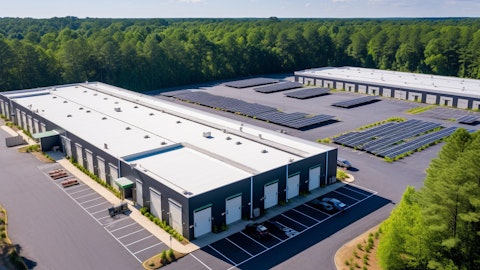Tom Boyle: No, I’d point you to — all of that commentary that we had on the February call as intact as it relates to the assumptions that underlie the range there. And as you’d anticipate, the next three months are going to be important as to which directions we’re heading on certain of those metrics. We’ve been encouraged by performance to date and we’ll have more to talk about ranges and things like that as we move through the year.
Todd Thomas: And then following up on that. Is there a scenario in which move-in rents remain a little bit weaker than you anticipated down double digits or high single digits, but occupancy continues to improve and you end up closing that gap entirely? And if so, what would that look like, what would the sensitivity around the model look like for guidance purposes, if there was an outcome in that sort of direction?
Tom Boyle: I mean, there’s definitely a range of outcomes and assumptions that you can make on the revenue modeling. I think what you’re highlighting is, if you have better occupancy performance but worse rate performance but if you end up in the same spot, could you end up in the same places you otherwise would have anticipated. Absolutely.
Todd Thomas: And just last question then. One of your peers saw a slight uptick in vacate activity. And it sounded like that there was an expectation that there’d be some sort of continued normalization around vacates and in the length of tenant stays. Your vacate activity was lower in the quarter versus last year. And I’m just wondering, if you expect that to continue or do you see potential for vacate activity and the length of stay trends to normalize a bit more going forward?
Tom Boyle: So I think there’s a couple of parts to that question, Todd. I think the first one is around length of stays and what we’ve seen trend wise. And we’ve been really pleasantly surprised over the last several years at how sticky the length of stay has been. When we were sitting here on calls in 2021, we were concerned that maybe there’d be a pretty quick return to normal or pre-pandemic length of stays and we’re now sitting here in 2024 still talking about longer length of stays compared to pre-pandemic levels. But we’re certainly off of those 2021 and 2022 peaks. And so there has been a normalization. But I think some of the factors that have led to longer length of stay are durable. We’ve talked about customers that are using storage because they ran out of space in their home, less housing turnover likely leads to longer length of stays.
All these things can be a positive as it relates to length of stay. And so while we’re off the piece, we still remain encouraged by customer behavior and the length of stays that we’re seeing in the portfolio today. So it may be the first part. The second part is, how are we thinking about move-out activity and move-out activity, I think, in the midpoint case is for basically flat year-over-year move-out activity. So we’re not anticipating a spike in that midpoint case.
Joe Russell: And then maybe just a third component from a macro health of customer standpoint with plus or minus 85% of our customers being consumers, employment trends continue to validate, the economy is in very strong shape. We’re not seeing any elevated level of stress play through that even takes us back to prepandemic levels, i.e., they’re better. Payment patterns, delinquency patterns, et cetera, are still in a very good zone. We’re not seeing any new and undue stress that’s coming through on the customer environment as a whole. So we continue to be very pleased and confident about our ability to see that level of stability with our existing customer base.
Operator: Our next question is from Eric Luebchow with Wells Fargo.
Eric Luebchow: Just wanted to touch on same store expenses a little bit. I saw slightly elevated growth in property taxes. I think you had guided to that being up about 5%. So maybe kind of is there any kind of seasonality to think about throughout the year in property taxes and then also marketing expenses up significantly/ How should we think about how those trends throughout the year given the unique dynamics of this year with spring leasing coming up?
Tom Boyle: So as you highlighted, operating expense for the quarter was above our full year outlook. And so we are anticipating that overall operating expense trends will improve. And so you’ve hit on a couple of the drivers of that and I’ll elaborate on a couple of others. The first one, property tax, we still are anticipating property tax to be plus or minus 5% year-over-year growth for the year. The first quarter did have some reassessments that were earlier in the year this year that was kind of onetime related. On the marketing topic, similarly, if you look at marketing spend in the first quarter, it was pretty consistent with the fourth quarter, which is a little bit higher seasonally. We’d anticipate marketing spend both on an absolute basis but also on a year-over-year basis to moderate a little bit as we move through the year, obviously, depending on customer demand activity and the like, but that’s another driver.
But I would also add two others. One is our capital investments that we’re making in solar power on our rooftops, which has a myriad benefits for us, obviously, the environment and our customer base. And one of the factors there will be lowering utility expense. We had that in the first quarter but that’s going to continue as we move through the next couple of quarters. And then also the technology investments that we’ve made around our customer interaction now, over two thirds of our customers are coming to us and renting digitally before they ever show up at a property, that number continues to grow. And we’ve been very clear around some of the opportunities to utilize that for specialization and centralization of roles and lower payroll expense as we move through the year, and we’ll see more of that heading through 2024 as well.
Eric Luebchow: And just on a — for a follow-up, you mentioned some of the risks of development right now, you’re seeing longer lead times for things like entitlement, higher construction costs, higher interest expense. So it seems like PSA is really leaning in now. A lot of your competitors may be pulling back. But do you have any change in your outlook to get to kind of an 8% NOI yield bogey within three to four years, which I think was your historic underwriting? Anything you can call out specific where the markets you’re developing today, the supply conditions, the competitive intensity, why you’re — what gives you the confidence you can get to those type of returns?





